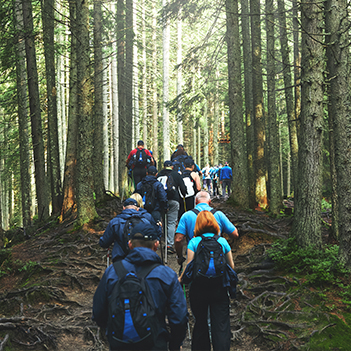Lostock Hall. Tues. 31 January 17
The Pictures:-
To see who was on the walk click on the following picture:-
To view all the pictures taken on the walk click 'HERE' then again on the first picture to view in full screen. Click small arrow on right to continue.
The Walk:-
Walk leader - Greg Hickey
Distance - 11.2 miles
Number on walk - 23 + 3 dogs.
Weather - Grey and grizzly but mainly dry.
On a day when the sky was the colour of an old vest and looked like staying that way, 23 of us, with Greg in the lead, left his house and headed along Todd Lane North to where we joined The Old Tram Road (sorry Greg not the old railway line), now a footpath and cycleway. This tramway transported goods, mainly coal one way and limestone the other way, between the Leeds/Liverpool Canal at Walton Summit and the Lancaster Canal Basin.
The five-mile-long tramroad comprised a double-track plateway, except for a short section of single track through a tunnel under Fishergate in Preston, just south of the canal basin. The iron rails were ‘L’ shaped in section and were spiked to large limestone blocks. The wheels on the waggons were not flanged and it was the vertical section on the iron rails that kept the wheels on the track. The gauge was 4 foot 3 inches (1295 mm) between the verticals, which were on the inside of the track.
The waggons were pulled by horses, up to six at a time, and each waggon had a capacity of two tons. Originally there were three inclined planes where the waggons were hauled via stationary steam engines and a continuous chain.
The tramroad crossed the River Ribble on a timber trestle bridge. This structure outlived the tramroad by nearly one hundred years and was replaced by a precast concrete structure to the same design in the 1960s.
As was common on early ‘railway’ systems, the waggons could be privately owned by the hauliers themselves (known locally as halers) who paid the company a toll to use the tramroad. There were many accidents during the life of the tramroad, many involving the inclined planes with waggons running away.
The last haler to work the tramroad, John Procter, walked the 10-mile return journey twice a day for 32 years. It has been estimated that he walked or rode nearly 200,000 miles (300,000 km) during his career on the tramroad, and needed his clogs resoling one per week.
Hey! Some long distance walker!
We followed the Old Tram Road down towards Preston, crossing the River Ribble over the Old Tram Bridge. We then turned West past Avenham and Miller Parks, re-crossing the River over the Old Penwortham Bridge. We then followed the South side of the River Ribble to the site of the former Preston Power Station on Holme Road, then onward through Howick and Penwortham, taking time out partway for lunch in Howick Hall Wood. After crossing Cop Lane we followed the path to Hill Road Cemetery, before crossing over Penwortham Way footbridge and down into Lower Penwortham/Middleforth. Here we rejoined the River Ribble, heading East along the South side of the River, now much higher in it's banks due to the tide having risen. Some distance on we rejoined the disused East Lancs Railway track, now a footpath and cycleway, passing the now derelict Vernon Carus bandage factory. At this point we were able to link back on to the Old Tram Road, which we followed back to Todd Lane North and along to Greg's House.
Was his the end of our pleasures? Not on your life, as not only had Greg taken us on an interesting and instructive walk, he then fed us with huge helpings and seconds of excellent hotpot. Thanks a lot Greg it was very much appreciated. You also kept the rain off until most of us had finished our hotpot. Donations amounting to £32.67 were meanwhile collected for and sent off to Air Ambulance. See 'Latest News'.
Stan.







